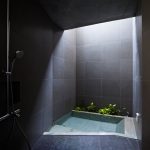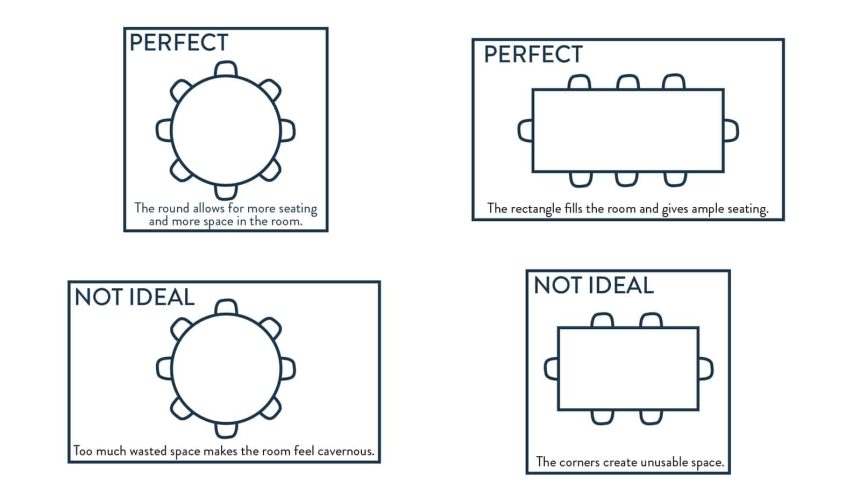If you’re in the market for a dining table, but you’re not exactly sure how to choose the best one, this post is for you. We don’t’ want to overwhelm you with the pros and cons of the four-post versus the trestle or pedestal dining table. We’re more interested in giving you the general considerations that you can apply to all three.
But since you are already curious, these are the basic differences of each design. A four-post table balances the full weight of the table on four legs set at the table’s corners. The legs of a trestle are typically inset and braced by either an X, H, or a box stretcher for additional support. A pedestal table has a central supporting structure and most often means a round top.
The following standard considerations apply when investing in any piece of furniture especially one as vital and as central as the supper table: available space, size and shape, and quality of construction.

How much space do you have?
It is of the utmost importance to consider the space you have before buying a trestle or a pedestal table of any size or shape. In general the these two types of tables tables are a great option for rooms with little space or for a banquette (built in bench area). For ultimate comfort and mobility, the general rule of thumb is that you should allow three to four feet of space around your table. That’s from the edges of the table to the nearest wall(s) or large piece of furniture in the room.
The most certain way to determine how much table your space can handle is to break out the tape measurer and physically map out the height, width, and length of your ideal table. You can use other pieces of furniture as scale models. Some even use bed sheets to replicate length and width. Our favorite method is using good ‘ol painters tape.
What shape is best for the room?
You have options: square, rectangle, and round. Although there may be a greater number of choices when it comes to square and rectangle, a round pedestal dining table might be the better option. As previously stated, they are more conducive to smaller spaces. Additionally, a round table in a tight space isn’t as visually unforgiving nor is it as physically hazardous as one with corners. Furthermore, their design encourages more communication between those sitting down for a meal, and it’s easier to add an extra place setting if needed.

How many people can you seat?
The Round | Brace yourself. There’s math involved. To determine how many people can comfortably sit at a round pedestal dining table, simply take the diameter (the width of the round table) and multiply by Pi (3.14). Then, divide that value by 24. Why 24? I’m glad you asked. No matter the shape of the table, each person seated needs 24 inches to be seated comfortably. So a 48” wide Yorkshire [(48 x 3.14)/24)] equals a maximum of 6.28 comfortably seated humans. The .28 I assume is the family rescue Spaniel mix.
The Square | We’re dealing with perimeter here, people. So, for a square pedestal dining table, you would add up the length of all the sides and divide by 24. Take for instance the 60 by 60 top on our Brecker square pedestal. Although the math says 10, it would only comfortably seat 8. The corners eliminate two place settings. Math. Am I right?
The Rectangle | The most important question you have to ask yourself is: Will I or my guests be comfortable straddling the trestles or pedestal? (Rectangular pedestal dining tables typically require two pedestals.) If you and your guests are equally amicable, the math is simple. Just take the total table length and divide by 24. This gives you a rough idea of how many people can be seated along the length of the table. If you and your guests would prefer not to straddle and have all the elbow room, grab your pen and pad because . . . more math. To fit your guests in the open spaces between the trestles or pedestals, you will have to account for and subtract the distance of the overhang and the overall width of the trestle or pedestal from the length of the table. Here is a diagram to help. The mathematical equation is underneath it.
This 90” table will comfortably seat six people: two on each side, one on each end. More table will equal more comfort. Chances are, this table will be with your family for decades to come. Therefore, it’s paramount that it meets your needs.
Luckily for all of us, the “Customize Item” feature on all Unruh Furniture products does this math for you. Just select the measurements that you’ve mapped out and view the “Sizing Information.” Here you’ll see the ideal seating and the minimum room dimensions that can accommodate your table.
How well is it built?
Look for sound and simple construction. A good pedestal dining table will have a finish that can withstand everyday use without obvious signs of wear. The joinery—where the base and tabletop fit together—should be simple. Simple construction connotes strength. Though wood-to-wood joinery is the strongest, some trestle or pedestal dining tables have metal bases with wooden tops. Still, the same joinery rules apply.
Check the piece for cracks, gaps, bent screws. Additionally make certain that the piece is wobble free. When standing from the seated position, brace yourself against the table. It shouldn’t lurch toward you. If the table is already showing signs of imbalance and deterioration before you get it home, it’s best to leave it where it is.
Ultimately, when choosing the right trestle or pedestal dining table, you should channel your inner Goldilocks and iconic Seusical lawyer. You want the table that is just right for you, and if it does not fit, do not commit.
Kitchen Image By:Style and Grace Interiors










